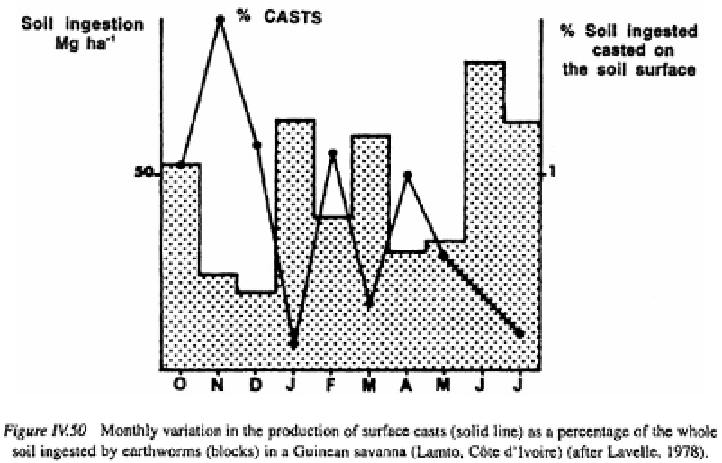Agriculture Reference
In-Depth Information
in humid soils with a near-neutral pH and relatively high concentrations of nutrient
elements and organic matter (Fragoso and Lavelle, 1992). They usually comprise 75 to
99 % of earthworm biomass in most humid tropical pastures and some tropical forests
of tropical America and western Africa (Lavelle, 1983c).
Finally, there is some evidence that endogeics and anecics may occur at different
times during successional processes. Endogeics may feed on the faecal pellets of litter
invertebrates and litter-feeding earthworms, and thus predominate in successions
after litter feeders have converted large amounts of plant material into pellets that the
endogeic species may ingest. This situation has been observed
e.g.,
by Cluzeau (1992)
in successional processes triggered by the input of domestic wastes into natural
heathland in Brittany (France). Similar successional processes seem also to occur in
rubber plantations where the carbon from trunks left at the soil surface after clearing
the forest, is first used by xylophagous termites, and then transferred to humivorous
termites and endogeic earthworms that feed on the faecal pellets deposited in the upper
few centimetres of the soil (Gilot
et al.,
1995).
4.3.2
ENDOGEIC STRUCTURES
Endogeics produce casts within the soil and at the soil surface. Annual production
of surface casts may be as high as as shown in Costa Rican tropical
pastures colonised by endogeic populations (Fraile, 1989). Even higher figures of
have been recorded from the moist savannas of the Côte d'Ivoire and the
Cameroons (Kollmannsperger, 1956; Lavelle, 1978). However, at Lamto (Côte d'Ivoire),
surface casts only represent 1.7 to 3.5 % of the of dry soil that endogeic
earthworms annually ingest. Interestingly, this proportion varies seasonally, probably
as a response to soil compaction and is at a maximum when the overall soil ingestion is
at its lowest (Figure IV.50).




